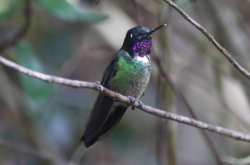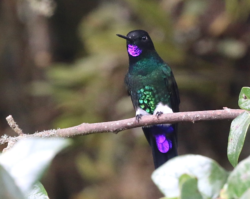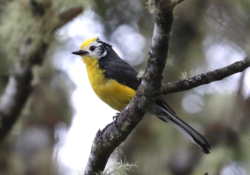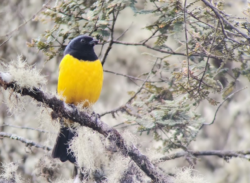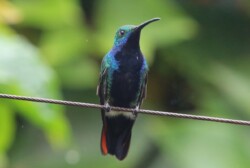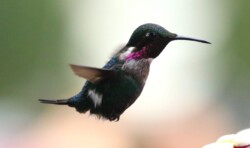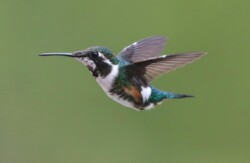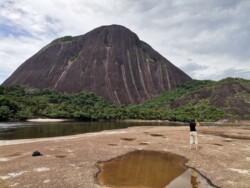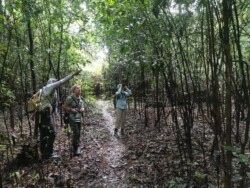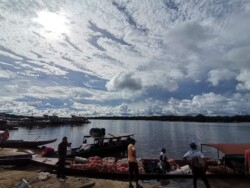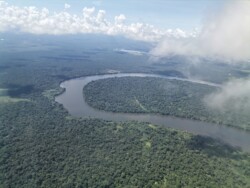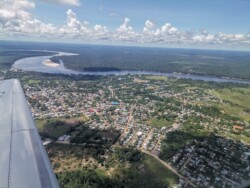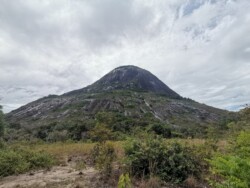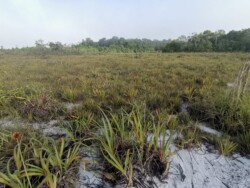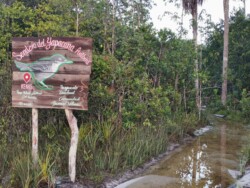December 2021
Deidre Absjorn returned to Colombia for a second visit, this time to the Mid-Magdalena Valley and Inirida in the far east of the country. She was accompanied by Lisa Wolf, who would provide the best photos of the trip.
The journey began in Bogotá, where they visited the outskirts of the Chingaza National Natural Park and the hummingbird observatory. The dwarf forest of Chingaza provided excellent views of several mountain tanagers, as well as hummingbirds and other interesting species such as the Black-chested Mountain-Tanager, the endemic Muisca Antpitta, Rufous-browed Conebill, Plushcap, Purple-backed Thornbill, and the Coppery-bellied Puffleg, among many others.
After a morning full of birds, they visited the hummingbird observatory, a private property in the mountains of La Calera above Bogotá and near Chingaza. They were able to watch at the feeders various hummingbird species such as Glowing Puffleg, Great Sapphirewing, Black-tailed and Green-tailed Trainbearers, Sword-billed Hummingbird, and the superb Blue-throated Starfrontlet, a colorful bird restricted to a small area in the mountains of the Eastern Andes from Colombia to Venezuela.


On their second day, they began their descent into the Magdalena Valley, which lies between the Eastern and Central Cordilleras. Before that, they stopped for a short visit to La Florida Park, which protects an important wetland for the preservation of species such as the endemic Bogotá Rail, the Bogotá races of the Yellow-hooded Blackbird and the Spot-flanked Gallinule, and various aquatic species such as the Andean Duck and Pied-billed Grebe, among others.
As they began their descent down the eastern side of the Eastern Cordillera, they made a brief stop at Enchanted Garden, a small property that has attracted over a dozen species of hummingbirds from this region for more than 30 years.
In the afternoon, they drove to the Rio Claro Canyon Nature Reserve. However, they stopped along the way to look for some key species in one of the few wetlands near the Magdalena River, which gives the valley its name. They were greeted by a pair of Northern Screamers as soon as they arrived, followed by other species of interest such as the Yellow-Chinned Spinetail, Common Black-Hawk, and several overflights of the bullosa-like Chestnut-fronted Macaw. After this brief visual feast, they proceeded to the Rio Claro Canyon Nature Reserve cabins, where the arrival of night surprised them with the song of the Spectacled and Crested Owls.
On their third day, they hiked the Rio Claro Canyon Nature Reserve’s trails. They had barely left their rooms in the La Mulata cabins, which are surrounded by lush tropical rainforest when they were greeted by a Spectacled Owl. A walk along the marble path that runs along the river’s banks allowed them to observe the Magdalena Antbird, which lives on the rocky slopes with sparse vegetation. Among the many birds, they saw that morning, the endemic White-Mantled Barbet was discovered feeding on a ficus tree with the Gartered and White-tailed Trogons. They also saw the bulbous but inconspicuous Blue-black Grosbeak, the Broad-billed Motmot, and some manakins such as the White-bearded and Golden-headed.
After a well-deserved rest, they explored the main trail, where a pair of Gray-cheeked Nunlet opened the afternoon, followed by a parsimony where the Barred Puffbird, the Russet-winged Schiffornis, and the Band-backed Wren stood out for their peculiar forms of behavior, from the Wren’s frenetic movement to the Puffbird’s absolute immobility.
The fourth day was also jam-packed with birds. They went on a road that was surrounded by forest and semi-open areas, and they were entertained all morning by species such as Striolated Manakin, Bicolored Antbird, Slate-colored Grosbeak, Russet-winged Schiffornis, and two other Manakin species, Golden-headed, and White-bearded.
In the afternoon, they drove eastward to the well-known Blue-billed Curassow Bird Nature Reserve. The Proaves Foundation’s reserve protects important areas of tropical rainforest in the Serrania de las Quinchas, located in the eastern foothills of the Cordillera Oriental. They took a short hike after arriving and at the start of the night to see the much sought-after Choco Screech-Owl, which was only a few meters away.
We spent the next two days exploring the reserve’s various trails. In the early morning hours, we were entertained by a parade of tanagers and flycatchers, as well as overflights of various species of parrots and macaws. Midday is usually hot and calm, but the birds are back to work by mid-afternoon.
Among the many species we saw was the endemic and critically endangered blue-billed curassow, a frequent visitor to the lodge garden. We also saw another endemic, the beautiful woodpecker, after a long search. White-tailed, Black-tailed, and Gartered Trogons were seen along different trails. We also saw the bare-crowned antbird, which is found very close to the lodge.
Other specialties we saw included the Russet-winged Schiffornis, the endemic white-mantled barbet, the great tinamou, the White-fronted Nunbird, the blue-and-yellow macaw, the Citron-throated Toucan, the very rare Black-billed Flycatcher, the Southern Bentbill, and a Gray-headed Kite that perched very close to us.
After two days of seeing new species, we returned to the Rio Claro reserve area for one more night. The next morning, we had a few hours to enjoy the birds in the area before heading to the airport outside of Medellín. We saw a white-flanked Antwren and a chestnut-fronted macaw on a road outside the reserve.
We then drove on the old road to Cocorná on the eastern side of the central Andes. We added more species to our list, including the endemic beautiful woodpecker. We were able to get close-up photos of a group of Spectacled Parrotlets. Orange-chinned Parakeets were abundant, and we also saw several Bar-crested Antshrikes, which are only found in Colombia and Venezuela. We ended our day with a good look at a photographable Striolated manakin.
We flew to Bogotá in the afternoon to prepare for our flight the next day to Inirida, one of Colombia’s most impressive Amazon destinations. Our plane took off at noon and landed in the warm town of Puerto Inirida an hour and a half later. After landing, we went straight to our first two birding spots near town.
We found our first target, the Black Manakin, in a white-sand forest. A solitary Black-collared Hawk watched us from atop its perch. Other species of interest this afternoon included Cherrie’s Antwren, Black-Faced Tanager, Scarlet Macaw, Bronzy Jacamar, Green-tailed Goldenthroat, and a Plain-crested Elaenia. As dusk fell, we were able to see the first few minutes of Least Nighthawk activity. Not bad for our first afternoon in this remote part of Colombia.
The following four days, we visited a variety of habitats, including white-sand forests, terra firme forests, varzea, and granite formations with dry vegetation at the Mavecure monoliths. We went to the following places:
- Sabanitas indigenous community
- Guamal indigenous community
- Matraca
- Caño Cunuben
- El Paujil trail
- Caño La Rompida
- Mavecure Hills and El Remanso Indigenous community
- Inirida Flower trail
These locations are easily birded from the town, the Mavecure hills are the farthest of all (1.5 hrs by boat)
It isn’t easy to come up with a concise list of the most unique birds these days, but the following will give you a taste of what we had:
- Green-tailed Goldenthroat
- Scale-breasted Woodpecker
- Spot-backed Antwren
- Yellow-crowned Manakin
- White-crowned Manakin
- Capuchinbird
- Pompadour Cotinga
- Pale-bellied Mourner
- Brown-headed Greenlet
- Spix Guan
- Tiny Hawk
- Spangled Cotinga
- Green-tailed Jacamar
- Collared Puffbird
- Yellow-throated Woodpecker
- Varzea Schiffornis
- Lemon-chested Greenlet
- Rose-breasted Chat
- Dot-backed Antbird
- Orinoco Softail
- Wire-tailed Manakin
- Royal Flycatcher
- Chestnut-backed Antshrike
- Plain-crowned Spinetail
- Hooded Tanager
- Orinoco Piculet
- Plumbeous Euphonia
- Brown Jacamar
- Pied Lapwing
- Yapacana Antbird
- White-naped Seedeater
This birding trip is the perfect way to experience two of the most biodiverse regions of Colombia, with great opportunities to see and enjoy true rarities, endemic species, and restricted range species, and above all, the magnificent landscapes of the Colombian Amazon region. The gastronomy and the pristine forests of Inírida are undoubtedly an ideal complement to this trip and will leave memories that will last a lifetime.

